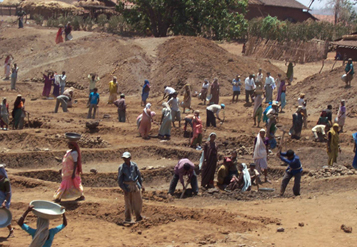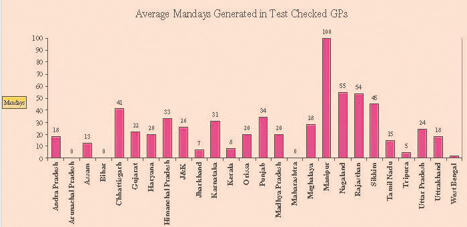
Archive 2009
|
February 1-15, 2008
National Rural Employment Guarantee Scheme: CAG's findings Every state was supposed to promulgate a Rural Employment Guarantee Scheme (REGS) along the lines of the Central Act. They were to prescribe time frame for each level – gram panchayat, block and district level – for proposing, scrutinising and approving REGS works. Each state was to set up a State Employment Guarantee Council (SEGC), as well as designate a State Rural Employment Guarantee Commissioner (SREGC). According to the CAG report, one state (Karnataka) delayed promulgating the REGS for as long as 14 months. 15 states did not prescribe the time frame for each level i.e. GP, Block and District levels for proposing, scrutinising and approving REGS works. Eight states did not designate any officer as SREGC. Four states had not established the State Employment Guarantee Councils. The audit revealed that in 43 of the 68 districts covered by the Survey, a District Perspective Plan (DPP) had not been prepared. These 43 districts were from 20 states. According to the CAG report, there was a shortfall in terms of works completed as compared to works planned in most of the states. This ranged from a shortfall of 1% in West Bengal to 97% in Maharashtra. Only in Tripura had the planned works been completed. There were projects that were being executed by non-technical staff like peons because of lack of technical staff. There were projects that were abandoned half way after spending a lot of money. There were projects where material-labour ratio had far exceeded the 40:60 ratio, making a mockery of the NREGA plan of providing employment. An example of the kind of misuse and misappropriation of funds is provided from two districts of Haryana – Sirsa and Mohindergarh. In Sirsa, while the material consumed in the district from April 2006 to February 2007 for pucca works was Rs. 3.87 crore, expenditure on purchase of stores in March 2007 alone was Rs. 3.61 crore. Also, the cash books of three blocks of the district for 2006-07 had not been closed as of June 2007, as transactions relating to the purchase of the material had not been completed. Clearly, the material was purchased merely to show utilization of funds, without assessing the requirement on works. Further, expenditure of Rs. 7.31 crore was spent on digging of 237 ponds. Check of records revealed lack of arrangements for filling the ponds with water, and complaints that people did not really need the ponds. Rs. 4.31 crore was spent on digging 257 ponds in Mohindergarh District, which is a drought prone area with scanty rainfall and where the soil is sandy and has no retention power. Block and GP officials admitted that the ponds dug under NREGS were without water. One pond had almost become a swimming pool, as 80 per cent of expenditure was incurred on material and masonry works. In many gram panchayats, the projects were being carried out without any plan or technical study, so there was a great likelihood that these projects would end up as worthless for society. In 46 of the 68 districts, covering 23 states, District Schedule of Rates (DSR) had not been prepared. Twenty-one States had not prepared lists of all tasks to be taken up under REGS in different geo-morphological conditions. Twenty states had not undertaken any work time and motion studies to observe “out turn” and fix rates after detailed specific observations. DSRs were not posted at work sites in 336 gram panchayats in 20 states. (It must be noted that the CAG team visited 513 gram panchayats. So 66% of the gram panchayats did not have a notice in the worksite of the wage rates.) In 294 gram panchayats from 16 states, (57% of the GPs surveyed) the implementing agencies did not provide description of daily work requirement to facilitate fulfilment of productivity norms. In 90 gram panchayats in 11 states, the workers were getting less then the minimum wages for the district. In 200 GPs in 18 States, (39%) workers were not being paid wages on time i.e. within a fortnight of the date on which the work was done. The audit team met villagers in Orissa who openly claimed they had not done the work, nor been paid the wages that the records claimed they were paid. The CAG report notes that non-payment of minimum wages, and delayed payment of wages is illegal, and also defeats NREGA’s objective of providing livelihood security. The CAG report further notes that in the absence of a detailed listing of tasks in different geo-morphological conditions, conduct of work, time and motion studies for fixing of productivity norms, and preparation of separate DSRs, the principle that seven hours of normal work should earn no less than the minimum wage is defeated. The CAG report is hinting that it suspects government officials are paying much less then the minimum wages to the workers under NREGA, as there are no reliable records from which it can be estimated how much labour was actually put into the works. CAG report points out that lack of publicity for DSRs and daily work requirements at work sites and GPs also contributes to lack of awareness of workers about their entitlements. The CAG Audit conducted a review of the employment provided (as per the Monthly Progress Reports of March 2007) in 465 GPs in 111 blocks in 26 States, which revealed that:
From the CAG report, it would appear that workers who did not get 100 days work did not get unemployment insurance. The CAG report notes that “in the absence of maintenance of critical registers, especially at the GP level, it is impossible to authentically verify:
It concludes that "The compliance with the legal guarantee of 100 days of employment on demand is not verifiable, based on available documents. In addition, transparency and accountability is adversely affected. Also, in the absence of these documents, the relevance of social audit is undermined." |


